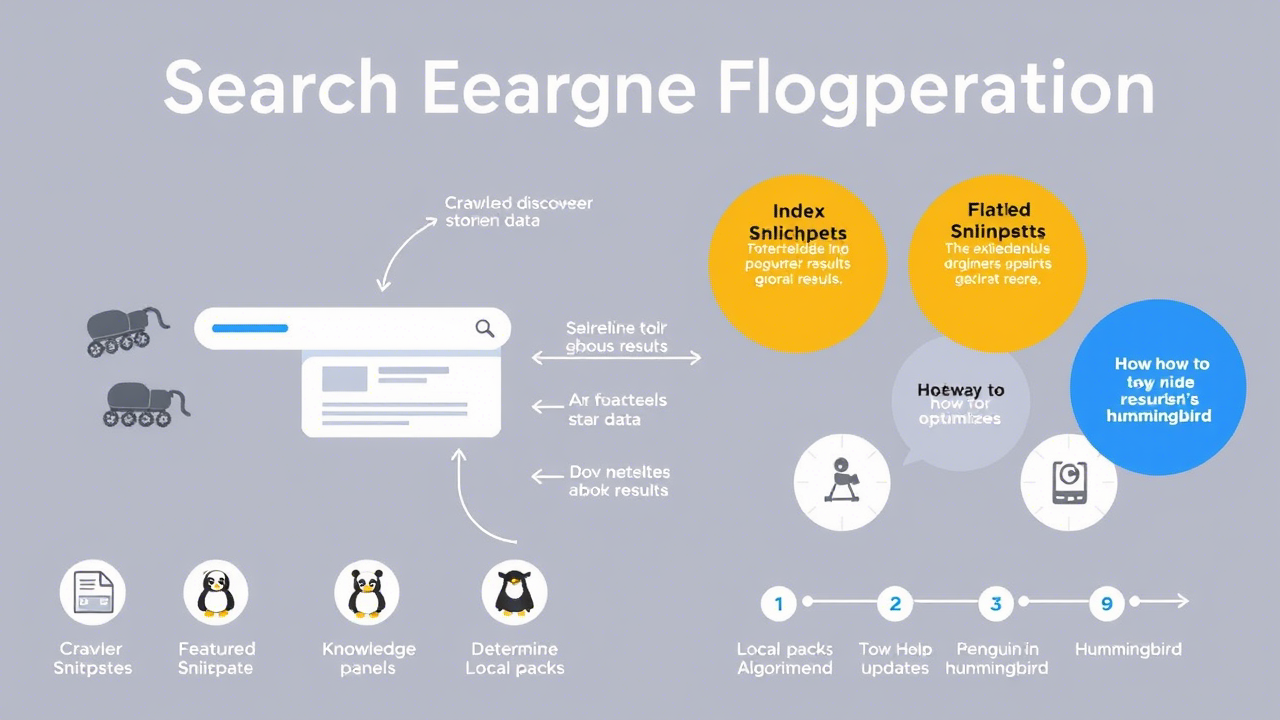Introduction

1.1 The Power of SEO
- Hook : Start with a shocking statistic or story.
- Example: “Did you know that 93% of online experiences begin with a search engine? Without a strong SEO strategy, your business risks being invisible to potential customers.”
- Why SEO Matters : Explain how SEO drives organic traffic, reduces customer acquisition costs, and builds long-term brand authority.
- The Evolution of SEO : Briefly discuss how SEO has evolved from keyword stuffing in the early 2000s to today’s AI-driven algorithms like Google’s RankBrain and BERT.
- What Makes This Article Unique : Highlight that this isn’t just another beginner’s guide—it’s a comprehensive deep-dive into mastering SEO at every level.
1.2 Why “SEO Unleashed”?
- Unleashing Potential : Define what “unleashed” means in the context of SEO—going beyond surface-level tactics to unlock advanced strategies.
- The ROI of SEO : Share real-world examples of businesses that saw exponential growth through SEO.
- Example: A small e-commerce store increasing sales by 300% after implementing an SEO strategy.
- Setting Expectations : Let readers know they’ll learn both foundational and cutting-edge techniques to dominate search engines.
1.3 What Readers Will Learn
- Provide a roadmap:
- Core principles of SEO
- Advanced tactics like voice search optimization and video SEO
- Tools and technologies to streamline workflows
- Case studies and actionable takeaways
- Future trends shaping the industry
Part 1: Foundations of SEO Mastery

1.1 Understanding Search Engines
- How Search Engines Work :
- Crawling: How bots discover new content.
- Indexing: Storing information about webpages.
- Ranking: Determining which pages appear first based on relevance and authority.
- The Anatomy of a SERP :
- Featured snippets, knowledge panels, local packs, and “People Also Ask” boxes.
- How to optimize for each type of result.
- Algorithm Updates :
- Timeline of major updates: Panda (content quality), Penguin (backlinks), Hummingbird (semantic search).
- Lessons learned from past updates and how to stay compliant.
1.2 Keyword Research: The Cornerstone of SEO
- Types of Keywords :
- Short-tail vs. long-tail keywords.
- Informational, navigational, and transactional intent.
- Tools for Keyword Research :
- Free tools: Google Keyword Planner, AnswerThePublic.
- Paid tools: Ahrefs, SEMrush, Ubersuggest.
- Competitor Analysis :
- Identifying competitors’ top-performing keywords.
- Finding gaps in their strategies.
- Building a Keyword Strategy :
- Aligning keywords with user intent.
- Prioritizing high-value keywords.
1.3 On-Page SEO Essentials
- Title Tags and Meta Descriptions :
- Best practices for writing compelling titles and descriptions.
- Using emotional triggers to improve click-through rates (CTR).
- Headers and Content Structure :
- Importance of H1, H2, and H3 tags.
- Writing scannable, engaging content.
- Internal Linking :
- Benefits of linking to other relevant pages on your site.
- Avoiding over-optimization penalties.
- Image Optimization :
- Compressing images for faster load times.
- Writing descriptive alt text for accessibility and SEO.
1.4 Technical SEO Fundamentals
- Site Speed Optimization :
- Techniques like lazy loading, minifying CSS/JS, and using CDNs.
- Tools for measuring speed: Google PageSpeed Insights, GTmetrix.
- Mobile-First Indexing :
- Ensuring your site is fully responsive.
- Designing for smaller screens without sacrificing functionality.
- Structured Data Markup :
- Implementing schema.org for rich results (recipes, reviews, FAQs).
- Testing structured data with Google’s Rich Results Test tool.
- Fixing Crawl Errors :
- Identifying broken links and 404 errors.
- Redirecting old URLs to new ones.
1.5 Off-Page SEO Strategies
- Backlink Building :
- Guest blogging: Writing valuable content for authoritative sites.
- Influencer outreach: Partnering with influencers to earn mentions.
- Social Signals :
- While not a direct ranking factor, social shares can indirectly boost visibility.
- Digital PR :
- Pitching stories to journalists and bloggers.
- Earning backlinks from reputable publications.
Part 2: Advanced SEO Tactics

2.1 Content Optimization at Scale
- Pillar Pages and Topic Clusters :
- Creating comprehensive pillar content around a broad topic.
- Linking related cluster articles to the main pillar page.
- Repurposing Content :
- Turning blog posts into videos, infographics, or podcasts.
- Maximizing ROI by distributing content across multiple channels.
- Updating Old Content :
- Revisiting outdated blog posts to refresh statistics and add new insights.
- Using tools like Ahrefs to identify underperforming content.
2.2 Voice Search and Conversational SEO
- Optimizing for Voice Assistants :
- Targeting natural language queries (“Where’s the nearest coffee shop?”).
- Focusing on long-tail keywords and question-based phrases.
- Local SEO for Voice Searches :
- Optimizing Google My Business listings.
- Encouraging positive reviews to improve local rankings.
2.3 Video SEO
- YouTube Optimization :
- Writing keyword-rich titles, descriptions, and tags.
- Adding timestamps and chapters for better navigation.
- Transcripts and Captions :
- Improving accessibility and helping search engines understand your content.
- Embedding Videos on Webpages :
- Increasing dwell time and reducing bounce rates.
2.4 International and Multilingual SEO
- Hreflang Tags :
- Specifying language and region variants for global audiences.
- Avoiding duplicate content issues between versions.
- Geo-Targeting Ads :
- Creating localized landing pages for different regions.
- Tailoring messaging to cultural preferences.
2.5 E-commerce SEO
- Product Page Optimization :
- Writing unique, persuasive product descriptions.
- Including high-quality images and customer reviews.
- Faceted Navigation :
- Avoiding thin content penalties with proper URL structures.
- Schema Markup for Products :
- Displaying prices, availability, and ratings directly in SERPs.
Part 3: Data-Driven SEO

3.1 Setting Up Analytics Tools
- Google Analytics Setup :
- Tracking organic traffic, bounce rates, and conversions.
- Setting up goals and funnels to measure performance.
- Google Search Console :
- Monitoring impressions, clicks, and average position.
- Submitting sitemaps and fixing crawl errors.
3.2 Interpreting SEO Metrics
- Key Performance Indicators (KPIs) :
- Organic traffic growth, keyword rankings, domain authority.
- Benchmarking against competitors.
- Identifying Patterns :
- Analyzing seasonal trends and algorithm impacts.
- Spotting anomalies in traffic or rankings.
3.3 A/B Testing for SEO
- Split-Testing Elements :
- Headlines, CTAs, meta descriptions, and even entire page layouts.
- Using statistical significance to validate results.
- Content Experiments :
- Comparing different formats (text vs. video) or tones (formal vs. casual).
3.4 Personalization and User Experience (UX)
- Leveraging Behavioral Data :
- Serving personalized recommendations based on browsing history.
- Improving UX metrics like Core Web Vitals (LCP, FID, CLS).
- Reducing Friction Points :
- Simplifying navigation and checkout processes.
- Enhancing mobile usability.
Part 4: Tools and Technologies for SEO Success

Search engine optimization (SEO) has evolved from manual guesswork to a data-driven discipline powered by cutting-edge tools and technologies. In this section, we’ll explore the wide array of software, platforms, and innovations that can help marketers streamline their workflows, uncover insights, and dominate search engines.
4.1 All-in-One SEO Platforms
All-in-one SEO platforms are indispensable for managing campaigns efficiently. These tools combine multiple functionalities—keyword research, backlink analysis, rank tracking, and site audits—into one dashboard. Let’s examine some popular options:
Ahrefs
Ahrefs is a powerhouse for competitive analysis and keyword research. Its Site Explorer feature allows users to analyze competitors’ backlinks, organic keywords, and top-performing content. With its Content Gap tool, marketers can identify untapped opportunities by comparing their site against competitors’. Ahrefs also offers robust reporting features, making it easy to track progress over time.
SEMrush
SEMrush excels in versatility, offering tools for SEO, PPC, social media, and content marketing. Its Position Tracking tool provides real-time updates on keyword rankings, while the On-Page SEO Checker delivers actionable recommendations for improving individual pages. SEMrush’s Domain Analytics suite helps marketers benchmark their performance against industry leaders.
Moz Pro
Moz Pro focuses on simplicity and accessibility, making it ideal for beginners and seasoned professionals alike. Its Keyword Explorer simplifies the process of finding high-value keywords, while the Link Explorer uncovers valuable link-building opportunities. MozBar, a free browser extension, enables quick SEO audits directly from SERPs.
Screaming Frog
For technical SEO enthusiasts, Screaming Frog is an essential tool. This desktop application crawls websites to identify issues like broken links, duplicate content, and missing meta tags. It also generates XML sitemaps and analyzes page speed metrics, ensuring your site meets Google’s standards.
4.2 Automation and AI in SEO
Artificial intelligence (AI) is revolutionizing SEO by automating repetitive tasks and providing deeper insights. Here’s how AI-powered tools are transforming the field:
Automation Tools
Tools like Zapier and Make (formerly Integromat) integrate various SEO platforms, enabling seamless workflows. For example, you can automate report generation by pulling data from Google Analytics, Search Console, and Ahrefs into a single dashboard. This saves hours of manual effort and ensures accuracy.
AI-Powered Content Generation
Platforms like Jasper AI and Copy.ai leverage natural language processing (NLP) to create SEO-optimized content quickly. While human oversight is still necessary, these tools excel at drafting outlines, writing product descriptions, and generating blog post ideas based on trending topics.
Predictive Analytics
AI-driven analytics tools, such as BrightEdge and MarketMuse, predict future trends by analyzing vast datasets. They help marketers anticipate shifts in consumer behavior and adjust strategies accordingly. For instance, if a particular keyword cluster shows rising interest, predictive analytics can prompt preemptive optimization efforts.
4.3 Link-Building Tools
Earning high-quality backlinks remains a cornerstone of off-page SEO. Fortunately, several tools simplify the outreach process:
HARO (Help a Reporter Out)
HARO connects journalists with expert sources, providing a unique opportunity to earn authoritative mentions. By responding to relevant queries, businesses can secure backlinks from reputable publications without spending money on ads.
BuzzStream and Pitchbox
These tools facilitate relationship-building with influencers and publishers. BuzzStream organizes contact information, tracks communication history, and monitors campaign performance. Similarly, Pitchbox automates personalized email outreach, increasing response rates and streamlining collaboration.
4.4 Local SEO Tools
For businesses targeting local audiences, specialized tools ensure maximum visibility in “near me” searches:
BrightLocal
BrightLocal offers comprehensive solutions for managing local SEO. Its Citation Builder ensures consistent NAP (Name, Address, Phone Number) listings across directories, while the Review Monitoring tool alerts businesses to new feedback on platforms like Google My Business and Yelp.
Whitespark
Whitespark specializes in citation building and review management. Its Local Rank Tracker monitors daily ranking fluctuations for location-specific keywords, helping businesses stay ahead of competitors.
By leveraging these tools and technologies, marketers can supercharge their SEO efforts and achieve sustainable growth.
Part 5: Case Studies and Real-World Examples

Real-world examples bring theoretical concepts to life, demonstrating how effective SEO strategies translate into tangible results. In this section, we’ll explore case studies spanning different industries and business sizes.
5.1 Small Business Success Stories
Small businesses often face resource constraints but can achieve remarkable outcomes with targeted SEO strategies.
Case Study: A Local Bakery
A small bakery in Chicago struggled to attract foot traffic despite offering delicious treats. After implementing a localized SEO strategy, they saw a 150% increase in store visits within six months. Key tactics included:
- Optimizing their Google My Business profile with high-quality photos and regular updates.
- Targeting long-tail keywords like “best cupcakes near me.”
- Encouraging satisfied customers to leave positive reviews, which boosted their local pack ranking.
Lessons Learned
This case highlights the importance of consistency in branding and leveraging user-generated content to build trust.
5.2 Enterprise-Level Campaigns
Large organizations require scalable SEO strategies to maintain global visibility.
Case Study: An E-commerce Giant
An international e-commerce retailer wanted to expand its presence in emerging markets. Through multilingual SEO and geo-targeted campaigns, they achieved a 200% increase in organic traffic. Tactics included:
- Translating product descriptions and landing pages into regional languages.
- Implementing hreflang tags to prevent duplicate content issues.
- Partnering with local influencers to amplify brand awareness.
Key Takeaways
Enterprise SEO requires meticulous planning and coordination across teams to execute successfully.
5.3 Lessons from Algorithm Updates
Google’s algorithm updates have reshaped the SEO landscape, forcing marketers to adapt or risk penalties.
Case Study: Recovering from Penguin
A SaaS company experienced a sharp decline in traffic after the Penguin update penalized their unnatural backlink profile. To recover, they conducted a thorough audit, disavowed toxic links, and focused on earning high-quality backlinks through guest blogging and digital PR. Within three months, their rankings rebounded, and organic traffic surpassed previous levels.
Best Practices
Regular audits and proactive adjustments are crucial for staying compliant with algorithm changes.
Part 6: Future Trends in SEO

As technology advances, so does SEO. Staying ahead of emerging trends ensures your strategy remains relevant and effective. Here are some key developments shaping the future of SEO:
6.1 Artificial Intelligence and Machine Learning
AI and machine learning are becoming integral to SEO, enabling more accurate predictions and personalization.
Smarter Search Algorithms
Google’s Multitask Unified Model (MUM) represents a leap forward in understanding complex queries. MUM can analyze text, images, and videos simultaneously, delivering richer results. Marketers must focus on creating multimedia-rich content to align with these advancements.
Chatbots and Conversational AI
Voice assistants and chatbots are transforming how users interact with brands. Optimizing for conversational queries and implementing chatbot functionality can enhance customer experiences and drive conversions.
6.2 Visual and Immersive Search
Visual search is gaining traction, allowing users to upload images instead of typing queries.
Pinterest Lens and Google Lens
These tools enable users to discover visually similar products, presenting opportunities for e-commerce sites to optimize image alt texts and filenames.
Augmented Reality (AR) and Virtual Reality (VR)
AR and VR applications are redefining user engagement. For example, furniture retailers use AR to let customers visualize products in their homes before purchasing. Incorporating AR/VR elements into your SEO strategy can differentiate your brand.
6.3 Sustainability and Ethical SEO
Consumers increasingly value transparency and sustainability. Aligning your SEO strategy with these principles can foster goodwill and loyalty.
Green Hosting
Choosing eco-friendly hosting providers reduces carbon footprints and appeals to environmentally conscious consumers.
Ethical Data Practices
Ensuring compliance with data privacy regulations like GDPR builds trust and avoids penalties.
By embracing these trends, marketers can position themselves as innovators in the ever-evolving world of SEO.
Conclusion
Final Thoughts
- Recap the key takeaways from the article.
- Reinforce the importance of staying adaptable in the ever-changing world of SEO.





